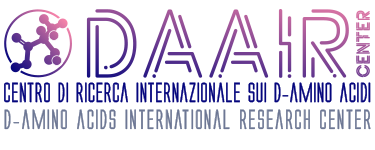

Do you have news concerning the D-amino acids field to announce? Is there a relevant published paper to mention? Write us and take the advantage of this bimonthly Newsletter.
The Editor’s pick selection of the most intriguing papers is highlighted in yellow.
D-AAs AND PATHOLOGIES:
Finding the Right Dose: NMDA Receptor–Modulating Treatments for Cognitiveand Plasticity Deficits in Schizophrenia and the Role of PharmacodynamicTarget Engagement
Sehatpour P., Kantrowitz J.T.Biol Psychiatry. 2025. 97(2):128-138. doi: 10.1016/j.biopsych.2024.08.019.
Cognitive impairment associated with schizophrenia (CIAS) and related deficits in learning (plasticity) areamong the leading causes of disability in schizophrenia but the development of treatments has been limited bynumerous failures of phase 2/3 studies. Here, the clinical trials in CIAS focusing on NMDAR modulatortreatments have been reviewed, focusing on direct and indirect NMDAR modulators, such as D-serine, D-cycloserine, memantine, and glycine and first-generation glycine transport inhibitors, as well as recent studies oficlepertin, a novel glycine transport inhibitor, and luvadaxistat, a D-amino acid oxidase inhibitor.
Therapeutic potential of D-amino acid oxidase inhibitors for cognitiveimpairment associated with schizophrenia: learnings from luvadaxistat
Terry-Lorenzo RT, Fan RH, Khin NA, Singh JB.Int J Neuropsychopharmacol. 2024. 28(1):pyae066. doi: 10.1093/ijnp/pyae066.
Hypofunction of the N-methyl-D-aspartate receptor (NMDAR) has been proposed to underlie thepathophysiology of schizophrenia, suggesting that promoting NMDAR activity may alleviate the negative orcognitive symptoms of schizophrenia. An indirect way to increase endogenous D-serine and glycine levels in the brain is represented by the use of inhibitors of D-amino acid oxidase (DAAO) and glycine transporter 1,respectively. This review provides an overview of the evidence supporting the potential of NMDAR modulators ingeneral, and DAAO inhibitors in particular, as potential adjunctive treatments for schizophrenia. A special focusis given to preclinical and clinical data related to luvadaxistat, a potent DAAO inhibitor.
Effect of D-amino acid metabolic enzyme deficiency on cancer development—diffuse large B-cell lymphoma onset and gene expression analyses in DASPO-knockout mice
Nakade Y, Iwata Y, Harada K, Sato Y, Mita M, Hamase K, Konno R, Hayashi M, Kobayashi T, Yamamura Y, Toyama T, Tajima A, Wada T.
Amino Acids. 2024. 57(1):4. doi: 10.1007/s00726-024-03426-1.
Mice deficient in D-AA-related metabolic enzymes were examined for 900 days and the effects of altered D-AA metabolism on cancer development based on lifespan, pathological findings, and gene expression were investigated. Notably, the lifespan of female D-aspartate oxidase-knockout (DASPO−/−) mice was shorter than
that of the other group mice and these mice showed tumor-like masses in the liver, spleen, and small intestine (diffuse large B-cell lymphoma, DBCL). RNA sequencing of liver samples showed specific alterations in the expression of 71 genes in DASPO−/− mice compared to wild-type B6 mice. Patients with DLBCL exhibiting low DASPO expression demonstrated a shorter survival period than those showing high expression.
Dynamic profiling of intra- and extra-cellular L/D-amino acids metabolism incolorectal cell and intestinal epithelial cell
Deng W, Huang R, Pan Y, Sun C
J Pharm Biomed Anal. 2025. 255:116622. doi: 10.1016/j.jpba.2024.116622. In this paper, the intra- and extra-cellular metabolic distribution of L/D-amino acids in colorectal cell (HCT116)and human normal intestinal epithelial cell (NCM460) were determined using HPLC-MS/MS coupled with achiral probe. Compared with NCM460 cells, 13 amino acids showed a lower concentration within HCT116 cells,and L-Gln was even not detected. Concerning the extra-cell culture medium, the HCT116 cells consumed moreL-Gln, D-Phe and D-Leu, while L-Met was low ingested. Phenylalanine, tyrosine and tryptophan biosynthesis andarginine biosynthesis are the main pathways for intra-cellular metabolites and extra-cellular metabolites,respectively. A high concentration of D-amino acids did no significantly alter the proliferation of NCM460 cell,but influenced the profiling of amino acids metabolites, and further affect the proliferation of HCT116 cell.
D-AAS & PHYSIOLOGICAL ROLES:
Prebiotic formation of enantiomeric excess D-amino acids on natural pyrite
Li R, Deng Q, Han L, Ouyang T, Che S, Fang YNat Commun. 2024. 15(1):10130. doi: 10.1038/s41467-024-54481-x.
This work reports on the formation of enantiomeric excess (ee) D-amino acids through photocatalytic reductiveamination of α-keto acids on natural pyrite. Various amino acids with ee values in the range of 14.5–42.4%, areformed. This work finds a potential way to the prebiotic formation of D-amino acids, adding further evidence tothe origin of D-amino acids enantiomeric excess in natural systems.
D-AAS & BIOTECHNOLOGY:
Efficient kinetic resolution of D,L-phosphinothricin using an aminotransferase-mediated cascade
Yi P, Xu Y, Liu H, Hao Y, Liu M, Liu Z, Xue Y, Jin L, Zheng Y
Process Biochemistry. 2025. 149, 295–30. doi: 10.1016/j.procbio.2024.12.021 D-amino acid aminotransferase from Cytobacillus firmus (CfDAAT), showing significant tolerability to D,L-phosphinothricin (PPT) and high specific activity and affinity toward pyruvate, was used in a co-substrateregeneration system with D-amino acid oxidase and catalase. An efficient whole-cell biocatalyst was obtainedto coordinate the co-expression of the three enzymes. Under optimized conditions, a catalytic amount ofpyruvate fully converted 200 mM D-PPT (400 mM D,L-PPT) in 10 h, resulting in a PPO productivity of 3.33g⋅L−1⋅h−1.
D-Phenylalanine Alleviates the Corrosion by Desulfovibrio vulgaris in SalineWater
Li H, Kang Z, Ding C, Zhao X, Cao Y, Zhang B, Song C, Wang SACS ES and T Engineering. 2024. 4 (12), 2938 – 2948. doi: 10.1021/acsestengg.4c00362.
This paper focuses on the evaluation of the effect of D-phenylalanine on corrosion by Desulfovibrio vulgaris atthree salinity levels. While at low concentration (10 mg/L) D-Phe played little role in corrosion inhibition at lowsalinity (5 g/L), the corrosion decreased by 40.6% and 59.6% at moderate (15 g/L) and high salinity (20 g/L),respectively. It was proposed that D-Phe reduced the secretion of extracellular proteins, biofilm thickness, andsessile cells. Furthermore, transcriptome analysis found that indole, the signal molecule negatively regulatingthe biofilm formation, was increased by adding D-Phe at high salinity, as well as peptidoglycan reorganizationvia absorbing additional D-Phe, leading to weak bacterial adhesion.
Imine Synthesis by Engineered D-Amino Acid Oxidase from Porcine Kidney
Khangkhachit W, Shirai S, Iwasaki G, Asano YACS Omega. 2025. 10(2):2212-2221. doi: 10.1021/acsomega.4c09160.
In this work, variants of pig kidney D-amino acid oxidase (pkDAAO) – namely, Y228L/R283G and I230A/R283G- were used for the oxidation of methylbenzylamine (MBA) derivatives. (R)-Fl-MBA was the best substrate forsymmetric imine synthesis, providing almost stoichiometric conversion (100 mM) and achieving nearly 100% yield.Several (R)-MBA derivatives were used as substrates, and the corresponding symmetric and asymmetric imineswere synthesized.
Labelling of a live obligate anaerobe using fluorescent D-amino acids
Lewis B, Oludiran A, Progulske-Fox A, Dunn W
Anaerobe. 2025. 91:102939. doi: 10.1016/j.anaerobe.2025.102939.
The probing of live bacteria via the incorporation of fluorescent D-amino acids (FDAAs) during peptidoglycansynthesis has been shown to be practical for visualizing both Gram-positive and Gram-negative bacteria. Here,the applications of FDAA labelling for the fluorescent imaging of an obligate anaerobe was reported.
Fluorescent d-amino Acid-Based Approach Enabling Fast and Reliable Measureof Antibiotic Susceptibility in Bacterial Cells
Walenkiewicz B, VanNieuwenhze MS
ACS Chem Biol. 2025. 20(1):162-171. doi: 10.1021/acschembio.4c00639.
The threat of multidrug-resistant bacteria has been increasing steadily in the past years, posing a major healthrisk. This paper reports that a short-pulse fluorescent D-amino acid (FDAA)-based approach provides insight intobacterial antibiotic susceptibility and into the mechanism of action of the antibiotic. Using the FDAA-labelingsignal as a reflection of peptidoglycan (PG) integrity after antibiotic treatment, it was observed that drugstargeting PG biosynthesis resulted in a significant decrease in fluorescence, while antimicrobials affecting othercellular targets did not alter the fluorescence signals. The method was validated and optimized via fluorescencemicroscopy and spectrofluorometry, shortening the required time to 15 min and providing reliably reproducibleresults. The authors demonstrate that this protocol can be used to identify β-lactam-resistant bacterial strains.
ENZYMES ACTIVE ON D-AAS:
Evolution and Functional Diversification of Serine Racemase Homologs inBacteria
Uda K, Nishimura R, Li Y, Shimoda E, Miyamoto T, Moe LA
J Mol Evol. 2025. doi: 10.1007/s00239-024-10231-7. Online ahead of print.
While alanine and glutamate racemases are widespread in bacteria, serine racemase (SerR) is predominantlyfound in animals. In this study, 20 SerR homologous genes from 13 bacterial species spanning five phyla werecloned and recombinant proteins characterized. Six homologs exhibited serine dehydratase activity, while theremaining showed racemase activity with serine, aspartate, asparagine, or arginine. Phylogenetic analysisrevealed that bacterial and eukaryotic SerR homologs share a common ancestral gene, and substratespecificity has been independently modified during evolution. Residues at positions 146 to 148 and surroundingregions, located near the substrate-binding site, play a crucial role in substrate specificity and/or catalyticactivity.
D-AAS IN PEPTIDES AND PROTEINS:
Discovery of a highly potent, selective, and stable D-amino acid-containingpeptide inhibitor of CDK9/cyclin T1 interaction for the treatment of prostatecancer
Xu Z, Geng Y, Guan L, Niu MM, Xu C, Yang L, Liang S
Eur J Med Chem. 2025. 285:117248. doi: 10.1016/j.ejmech.2025.117248.
Cyclin-dependent kinase 9 (CDK9) plays a pivotal role in promoting oncogenic transcriptional pathways, thussupporting the cancer development and progression. This work reports on the first D-amino acid-containingpeptides (DAACPs) inhibitor targeting CDK9-cyclin T1. Peptide-5 showed nanomolar inhibitory effect againstCDK9-cyclin T1, was stably bound to CDK9, showed good inhibitory activity against multiple types of prostatecancer cells and demonstrated good biostability in mouse serum. Peptide-5 also suppressed the tumor growthin DU145 cell-derived xenografts nude mice.
Rational engineering of an antimalarial peptide with enhanced proteolyticstability and preserved parasite invasion inhibitory activity
Kar A, Narayan A, Malik V, Mandal K
RSC Chem Biol. 2024. 6(1):65-72. doi: 10.1039/d4cb00229f.
This paper describes rational chemical engineering to enhance the proteolytic stability of a chimeric peptideusing the incorporation of D-amino acids into the parent L-peptide sequence and restricting the conformationalfreedom of the peptide by covalent stitching. To verify this hypothesis, the peptidic inhibitor RR against P.falciparum invasion into red blood cells (RBCs) was used as model and two novel heterochiral chimericpeptides, RR-I and RR-II were designed. The latter peptides exhibit remarkable inhibitory activity with enhancedproteolytic stability. Finally, the cyclic analog RR-III was designed: it shows the same inhibitory activity as RR-IIwhile demonstrating impressive resistance to enzymatic degradation and prolonged stability in human plasma.
D-AAS AND ANALYTICAL METHODS:
An ultrasensitive colorimetric/fluorescent/photothermal sensing platform forthe detection of D-amino acids based on carbon dots nanozymes with enhancedperoxidase-like activity
Wu W, Ni C, Huang YL, Cheng HL, Shi YH, Zhang YH, Xu ZH, Zhang GQ
Mikrochim Acta. 2025. 192(2):95. doi: 10.1007/s00604-025-06961-0.
This work focuses on the quantitative detection of D-amino acids in saliva based on the enhanced peroxidase-like activity of carbon dots nanozymes (CDszymes) and the hydrogen peroxide formation by D-amino acidoxidase from D-amino acids. Using D-alanine as reference, the detection limits of in colorimetric, photothermal,and fluorescent modes were 0.3 μM, 1.8 μM, and 0.04 μM, respectively. The proposed detection platformexhibits promising application potential in clinical diagnostics.
A two-dimensional liquid chromatography approach for simultaneousseparation and quantification of structural and chiral amino acids in oolong tea
Zhang S, Ee KH, Goh RMV, Huang Y, Pua A, Jublot L, Li L, Liu SQ, Yu B
Food Chem. 2025. 472:142846. doi: 10.1016/j.foodchem.2025.142846.
Epub ahead of print. Oolong tea contains various D-amino acids, influencing both the flavor and bioactivity. By a two-dimensionalliquid chromatography method followed by quantification by quadrupole time-of-flight mass spectrometry, thepresence of D/L-Leu and D/L-Ile was demonstrated: figures of 0.08 μg/g for D-Ile and 22.34 μg/g for L-Leuwere determined, with RSD% below 5%.
Highly efficient chiral extraction of amino acid enantiomers using Wei-Phos-Pdas chiral extractant
Liu X, Qin S, Yang Y, Qiu S, Tang X, Peng L, Li S
Separation and Purification Technology. 2025. 354, 129187. doi: 10.1016/j.seppur.2024.129187
Wei-Phos, an adaptive chiral sulfinamide phosphine ligand featuring multiple coordination centers, was used asa chiral extractant to separate amino acid enantiomers. Wei-Phos-Pd is a highly efficient chiral extractant foramino acid enantiomers: D-amino acids are preferentially recognized. The separation factors for phenylalanine,homophenylalanine, 3-chlorophenylglycine, and 4-nitro-phenylalanine are 12.19, 8.89, 13.17 and 7.06,respectively.
Targeted Chiral Metabolomics of D-Amino Acids: Their Emerging Role asPotential Biomarkers in Neurological Diseases with a Focus on Their LiquidChromatography-Mass Spectrometry Analysis upon Chiral Derivatization
Lella C, Nestor L, De Bundel D, Vander Heyden Y, Van Eeckhaut A
Int J Mol Sci. 2024 Nov 19;25(22):12410. doi: 10.3390/ijms252212410.
The targeted chiral analysis of the brain metabolome, employing liquid chromatography coupled to massspectrometry, is a relevant method for the identification of biomarkers for neurological diseases. This reviewprovides an overview of D-amino acids in neurological diseases and of the state-of-the-art strategies for theenantioselective analysis of chiral amino acids in biological samples to investigate their putative role asbiomarkers for neurological diseases.
D-AAS AND ANALYTICAL METHODS:
Advances in Chiral Metabolomic Profiling and Biomarker Discovery
Pandey R, Tiziani S
Methods Mol Biol. 2025;2855:85-101. doi: 10.1007/978-1-0716-4116-3_5.
Chiral metabolomics entails the enantioselective measurement of the metabolome present in a biological system. D-Amino acids and D-hydroxy acids are now emerging as novel signaling molecules and potential biomarkers for various disorders. Here, the pivotal role of chiral metabolic profiling studies in disease diagnosis, prognosis, and therapeutic interventions has been outlined, as well as the cutting-edge chromatographic and mass spectrometry methods that enable enantioselective analysis of chiral metabolites.
An enzymatic reaction-based SERS saliva analysis microporous array chip for chiral differentiation and high-throughput detection of D-amino acids
Lu F, Li L, Shen K, Qian Y, Zhang P, Yang Y, Zhu Q, Huang Y, Yan C, Wei W Mikrochim Acta. 2024 Oct 8;191(11):653. doi: 10.1007/s00604-024-06733-2.
A Raman-active boronate modified surface-enhanced Raman scattering (SERS) microporous array chip based on the enzymatic reaction of D-amino acid oxidase (DAAO) was constructed for reliable, sensitive, and quantitative monitoring of D-proline and D-alanine in saliva. The I882 cm-1/I998 cm-1 ratio increased at higher content of D-AAs in the sample. The limits of detection were 10-14 µM throughout the linear range of 20-500 µM. The saliva detection suggested that this sensor could rapidly differentiate between early-stage gastric cancer patients and healthy individuals.
Tuning the peroxidase-mimic activity of CuX-trithiocyanuric acid complexes for colorimetric detection of gastric cancer-associated D-amino acids
Gao X, Zhu J, Zhao J, Zhao L, Sun Y, Lin J, Hu M, Liu Y, Yang S, Liu J
Sensors and Actuators B: Chemical, 2025, 424, art. no. 136871 doi: 10.1016/j.snb.2024.136871
Chiral metabolomics entails the enantioselective measurement of the metabolome present in a biological system. D-Amino acids and D-hydroxy acids are now emerging as novel signaling molecules and potential biomarkers for various disorders. Here, the pivotal role of chiral metabolic profiling studies in disease diagnosis, prognosis, and therapeutic interventions has been outlined, as well as the cutting-edge chromatographic and mass spectrometry methods that enable enantioselective analysis of chiral metabolites.
Enantiospecific profiling of D-amino acid for gastric cancer diagnosis by using a biocatalytic MHOF nanoreactor
Zhou Q, Zhang H, Zeng T, Yang J, Liang Q, Shi H, Yin Y, Li G.
Sensors and Actuators B: Chemical, 2025, 423, art. no. 136716 DOI: 10.1016/j.snb.2024.136716.
In this work, a nanoreactor based on mesoporous hydrogen-bonded organic framework (MHOF) has been fabricated for the enantiospecific profiling of D-amino acids. MHOFs act as the scaffold to organize the D- amino acid oxidase (DAAO) and horseradish peroxidase (HRP). Once D-AAs transport into MHOFs, the chromogenic reactions of 3,3′,5,5′-tetramethylbenzidine (TMB) and H2O2 is activated. This nanoreactor can be operated in complex solution and can be used for the profiling of D-AA levels in saliva samples collected from gastric cancer patients.
Recent Advancements in the Characterization of D-Amino Acid and Isoaspartate Post-Translational Modifications
Okyem S, Sweedler JV
Mass Spectrom Rev. 2024 Nov 18. doi: 10.1002/mas.21916.
IIn this work, several mass spectrometry (MS) and ion mobility techniques are reported, as well as other methods such as chromatography, enzymatic enrichment, and labelling, to characterize modifications that does not change the mass of a peptide, such as amino acid isomerisation. The authors reported the challenges inherent to these analytical methods and prospective developments in bioinformatics and computational strategies.
Enantiomer-Specific Stable Carbon and Nitrogen Isotopic Analyses of Underivatized Individual L- and D-Amino Acids by HPLC + HPLC Separation and Nano-EA/IRMS
Sun Y, Blattmann TM, Takano Y, Ogawa NO, Isaji Y, Ishikawa NF, Ohkouchi N Anal Chem. 2024 Nov 15. doi: 10.1021/acs.analchem.4c02851.
This paper reports on a novel method for stable carbon and nitrogen isotopic (δ13C and δ15N) analysis of underivatized amino acid (AA) enantiomers simultaneously, based on HPLC separation and off-line isotopic measurement. The separation of L- and D-enantiomers of 15 proteinogenous AAs was reported, with all L-ones eluting before the corresponding D-enantiomers. By coupling this column with a multidimensional HPLC system for isolating individual AAs, the enantiomers were determined in the peptidoglycan isolated from Gram-positive bacterium Bacillus subtilis.
Structure Derivatization of IgG-Binding Peptides and Analysis of Their Secondary Structure by Circular Dichroism Spectroscopy
Muguruma K, Fukuda A, Shida H, Taguchi A, Takayama K, Taniguchi A, Ito Y, Hayashi Y Chem Pharm Bull (Tokyo). 2024;72(9):831-837. doi: 10.1248/cpb.c24-00430.
This work focused on a structure derivatization of an immunoglobulin G (IgG)-binding peptide (15-IgBP), a β- hairpin-like cyclic peptide with a twisted β-strand and assessed the effect of the secondary structure on IgG- binding activity using circular dichroism (CD) spectra analysis. Derivatization at the Ala5 and Gly9 positions affected the secondary structure of 15-IgBP: the small methyl group at Ala5 is crucial for retaining the preferred secondary structure while Gly9 could be replaced by D-amino acids. Four potent affinity peptides for IgG binding (Kd = 4.24-5.85 nM). Furthermore, the Gly9 position can be substituted for D-Lys.
INFORMATION
The D-amino acids International Research Center “DAAIR“ has been established in Gerenzano (Varese, Italy) in 2019 with the aim to support and perform scientific research projects and activities on the field of D-amino acids. The Center, located inside the Fondazione Istituto Insubrico Ricerca per la Vita, is aimed to represent a pole of excellence at international level for dissemination and research involving the D-amino acids (Director Silvia Sacchi).

The guiding principle is to support the research projects aimed to investigate the involvement of D-amino acids in main physiological processes, from bacteria to humans. The ultimate goal is the elucidation of the mechanisms by which the D-amino acids perform specific functions, and to identify their presence and concentration in different organisms and compartments, with particular emphasis to pathological states: understand the involvement of D-amino acids in important diseases as a way to set up novel therapeutic strategies.
https://www.d-aminoacids.com/
mailing address: info@d-aminoacids.com
Commenti recenti